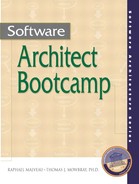9.5. Perception Is Not Reality
It is essential for you to understand some important aspects of mass psychology. Most people believe that "perception is reality" and "seeing is believing." And there may have been some time, before technology, when that was a reasonably effective way to think. But it is not so today. Perception is not reality because technology can falsify perceptions. Technology can create powerful illusions. And especially with computing technology, illusions are becoming easier and easier to manufacture.
For you as an architect, the ability to envision new illusions and impress them upon people's imaginations is vitally important. The architect works in the gray area between intuitive perception and the logical certainty of software. In order to translate intuitive system concepts into software reality, we must have a talent to envision architectural structures. Then we must be able to document these visions and articulate (explain) them in a way that sells the concepts to other people. In other words, we start system envisioning by creating an illusion, and then proceed to architect the system, providing more and more depth to the illusion, until it appears obvious what the system is about, why we should build it, and how it can be realized.
Not all system illusions are worth building even if they are very "sexy." It has been said that "whatever man can see and believe, man can achieve." Software development is an ideal refutation of this kind of wrong-think. A great majority of software projects envision illusions that cannot be effectively realized. In effect, many software projects are subject to the illusion of "imagination run rampant." The architect is responsible for moderating this situation. The architect has the power of imagination, like most people, but the architect is also responsible for managing risks, both technical and people-oriented, that could impact project success.
In an often-used analogy, software efforts are like building different types of cars. First we build a Ford Pinto (or Yugo). The system does something useful, but the engineering and manufacturing are not superb; in fact, they are just the opposite! Often the system does not meet the full expectations (system illusion) of the users. But in the eyes of the developers, if the system actually works, they gain much confidence and are ready to try again with much more ambition. When the team tackles the next system challenge, it builds a Cadillac with all the bells and whistles. With encouragement from the users, the system developers create overly ambitious requirements that cannot be effectively realized. Cadillac projects are likely failures. The project bogs down in trying to create too complex a system; the effort lacks focus. After this failure, the team takes a much more sober approach to the next system. This time they envision and build a Volkswagen Beetle, a modest system, but very practical and well engineered. It meets human needs and works reliably. That's the whole point.
As architects, we want to facilitate our projects to avoid these extremes. Architectural planning creates a solid system structure that goes beyond the engineering limitations of the Pinto/Yugo. We give the developers an excellent chance to avoid this phase of system evolution. We also argue against building the Cadillac system. We want to advise our colleagues to be practical and avoid the pitfalls where so many other projects have failed. Ideally, we want to design and build the VW on the first attempt. Sometimes you can't talk people out of making these classic mistakes, so you may get forced into building the Pinto/Yugo or Cadillac. At this point, it is okay to make your opinions well known, perhaps vehemently (we favor the adult-assertive approach). If they don't understand your concerns, then document them clearly and move on to new challenges. Do not dwell on lost battles or try to undermine the committed direction of a project, whether you are right or wrong, once you have lost the argument. As a computer scientist once said, "It is the fate of competent advisors to have their best advice ignored." As you already know, people don't listen.
